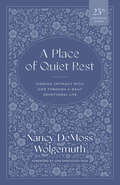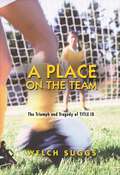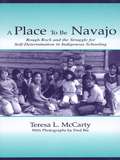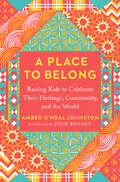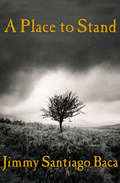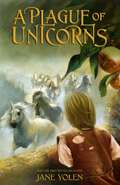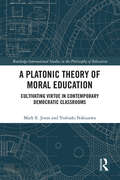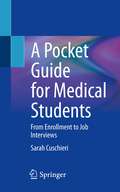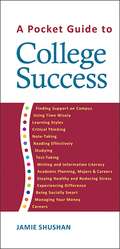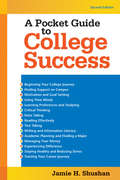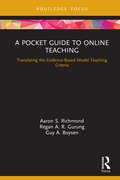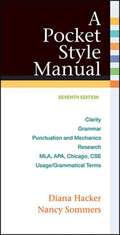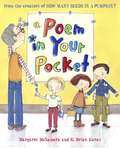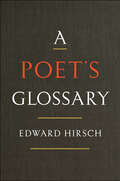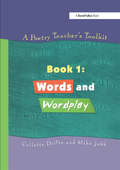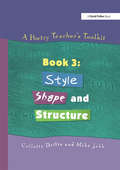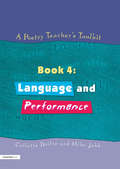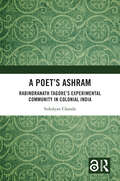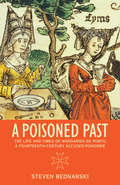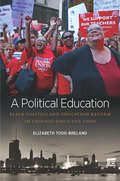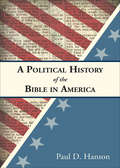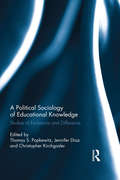- Table View
- List View
A Place of Quiet Rest: Finding Intimacy with God Through a Daily Devotional Life
by Nancy DeMoss WolgemuthThe God of the universe created us for a loving relationship with Him. We long for that sweet intimacy with God, but it often seems so out of reach. Yet even in the busyness of daily life, we hear those whispers calling us, drawing us to the feet of Jesus.Best-selling author Nancy DeMoss Wolgemuth demystifies the process of coming to know God intimately. For over 20 years A Place of Quiet Rest has spoken to readers, helping them to a deeper relationship with Christ. In A Place of Quiet Rest Nancy shares from her heart and life how a daily devotional time can forever change your life.This Nancy DeMoss Wolgemuth classic will encourage generations to come to find that place of quiet rest.
A Place on the Team: The Triumph and Tragedy of Title IX
by Welch SuggsA Place on the Team is the inside story of how Title IX revolutionized American sports. The federal law guaranteeing women's rights in education, Title IX opened gymnasiums and playing fields to millions of young women previously locked out. Journalist Welch Suggs chronicles both the law's successes and failures-the exciting opportunities for women as well as the commercial and recruiting pressures of modern-day athletics. Enlivened with tales from Suggs's reportage, the book clears up the muddle of interpretation and opinion surrounding Title IX. It provides not only a lucid description of how courts and colleges have read (and misread) the law, but also compelling portraits of the people who made women's sports a vibrant feature of American life. What's more, the book provides the first history of the law's evolution since its passage in 1972. Suggs details thirty years of struggles for equal rights on the playing field. Schools dragged their feet, offering token efforts for women and girls, until the courts made it clear that women had to be treated on par with men. Those decisions set the stage for some of the most celebrated moments in sports, such as the Women's World Cup in soccer and the Women's Final Four in NCAA basketball. Title IX is not without its critics. Wrestlers and other male athletes say colleges have cut their teams to comply with the law, and Suggs tells their stories as well. With the chronicles of Pat Summitt, Anson Dorrance, and others who shaped women's sports, A Place on the Team is a must-read not only for sports buffs but also for parents of every young woman who enters the arena of competitive sports.
A Place to Be Navajo: Rough Rock and the Struggle for Self-Determination in Indigenous Schooling (Sociocultural, Political, and Historical Studies in Education)
by Teresa L. McCartyA Place To Be Navajo is the only book-length ethnographic account of a revolutionary Indigenous self-determination movement that began in 1966 with the Rough Rock Demonstration School. Called Diné Bi'ólta', The People's School, in recognition of its status as the first American Indian community-controlled school, Rough Rock was the first to teach in the Native language and to produce a body of quality children's literature by and about Navajo people. These innovations have positioned the school as a leader in American Indian and bilingual/bicultural education and have enabled school participants to wield considerable influence on national policy. This book is a critical life history of this singular school and community. McCarty's account grows out of 20 years of ethnographic work by the author with the Diné (Navajo) community of Rough Rock. The story is told primarily through written text, but also through the striking black-and-white images of photographer Fred Bia, a member of the Rough Rock community. Unlike most accounts of Indigenous schooling, this study involves the active participation of Navajo community members. Their oral testimony and that of other leaders in Indigenous/Navajo education frame and texture the account. Informed by critical theories of education, this book is not just the story of a single school and community. It is also an inquiry into the larger struggle for self-determination by Indigenous and other minoritized communities, raising issues of identity, voice, and community empowerment. A Place To Be Navajo asks whether school can be a place where children learn, question, and grow in an environment that values and builds upon who they are. The author argues that the questions Rough Rock raises, and the responses they summon, implicate us all.
A Place to Belong: Celebrating Diversity and Kinship in the Home and Beyond
by Amber O'Neal JohnstonA guide for families of all backgrounds to celebrate cultural heritage and embrace inclusivity in the home and beyond.Gone are the days when socially conscious parents felt comfortable teaching their children to merely tolerate others. Instead, they are looking for a way to authentically embrace the fullness of their diverse communities. A Place to Belong offers a path forward for families to honor their cultural heritage and champion diversity in the context of daily family life by: • Fostering open dialogue around discrimination, race, gender, disability, and class • Teaching &“hard history&” in an age-appropriate way • Curating a diverse selection of books and media choices in which children see themselves and people who are different • Celebrating cultural heritage through art, music, and poetry • Modeling activism and engaging in community service projects as a family Amber O&’Neal Johnston, a homeschooling mother of four, shows parents of all backgrounds how to create a home environment where children feel secure in their own personhood and culture, enabling them to better understand and appreciate people who are racially and culturally different. A Place to Belong gives parents the tools to empower children to embrace their unique identities while feeling beautifully tethered to their global community.
A Place to Stand: The Making Of A Poet
by Jimmy Santiago BacaThe Pushcart Prize–winning poet’s memoir of his criminal youth and years in prison: a “brave and heartbreaking&” tale of triumph over brutal adversity (The Nation). <P><P> Jimmy Santiago Baca’s “astonishing narrative” of his life before, during, and immediately after the years he spent in the maximum-security prison garnered tremendous critical acclaim. An important chronicle that “affirms the triumph of the human spirit,” it went on to win the prestigious 2001 International Prize (Arizona Daily Star). <P><P> Long considered one of the best poets in America today, Baca was illiterate at the age of twenty-one when he was sentenced to five years in Florence State Prison for selling drugs in Arizona. This raw, unflinching memoir is the remarkable tale of how he emerged after his years in the penitentiary—much of it spent in isolation—with the ability to read and a passion for writing poetry. <P><P> “Proof there is always hope in even the most desperate lives.” —Fort Worth Star-Telegram <BR> “A hell of a book, quite literally. You won’t soon forget it.” —The San Diego U-T <BR> “This book will have a permanent place in American letters.” —Jim Harrison, New York Times–bestselling author of A Good Day to Die
A Plague of Unicorns
by Jane YolenYoung James, an earl’s son, is a bit bothersome and always asking the oddest questions. In despair—the last of James’ tutors having quit—his mother sends him off to be educated at Cranford Abbey. She feels the strict regimen will do him a world of good. But Cranford Abbey has its own problems. It has been falling into disrepair. The newly appointed Abbot Aelian takes it upon himself to save the abbey with the use of his secret weapon: a recipe for golden apple cider passed down in his family for many generations. He believes that by making and selling the cider, the monks will raise necessary funds to restore the abbey to its former glory. Abbot Aelian has everything he needs—almost. One obstacle stands in his way, unicorns that happen to feast specifically on the golden apples. Abbot Aelian and his men must fight off the unicorns to make the cider. He and the monks try to form a battalion to fight off the beasts; next they import heroes to fight for them. But the heroes run off, monks are injured, and a herd of ravenous unicorns continue munching. After no success, the abbot finally calls upon the most unlikely of heroes, one suggested by no other than young James. That hero is small and unprepossessing but possesses the skill to tame the beasts. Though wildly skeptical, Abbot Aelian must risk everything and believe in this recommended stranger or risk the fall of Cranford Abbey.
A Plan for Evaluating the District of Columbia's Public Schools: From Impressions to Evidence
by The National Academy of SciencesThe District of Columbia (DC) has struggled for decades to improve its public education system. In 2007 the DC government made a bold change in the way it governs public education with the goal of shaking up the system and bringing new energy to efforts to improve outcomes for students. The Public Education Reform Amendment Act (PERAA) shifted control of the city's public schools from an elected school board to the mayor, developed a new state department of education, created the position of chancellor, and made other significant management changes. A Plan for Evaluating the District of Columbia's Public Schoolsoffers a framework for evaluating the effects of PERAA on DC's public schools. The book recommends an evaluation program that includes a systematic yearly public reporting of key data as well as in-depth studies of high-priority issues including: quality of teachers, principals, and other personnel; quality of classroom teaching and learning; capacity to serve vulnerable children and youth; promotion of family and community engagement; and quality and equity of operations, management, and facilities. As part of the evaluation program, the Mayor's Office should produce an annual report to the city on the status of the public schools, including an analysis of trends and all the underlying data. A Plan for Evaluating the District of Columbia's Public Schools suggests that D. C. engage local universities, philanthropic organizations, and other institutions to develop and sustain an infrastructure for ongoing research and evaluation of its public schools. Any effective evaluation program must be independent of school and city leaders and responsive to the needs of all stakeholders. Additionally, its research should meet the highest standards for technical quality.
A Platonic Theory of Moral Education: Cultivating Virtue in Contemporary Democratic Classrooms (Routledge International Studies in the Philosophy of Education)
by Mark E. Jonas Yoshiaki NakazawaDiscussing Plato’s views on knowledge, recollection, dialogue, and epiphany, this ambitious volume offers a systematic analysis of the ways that Platonic approaches to education can help students navigate today’s increasingly complex moral environment. Though interest in Platonic education may have waned due to a perceived view of Platonic scholarship as wholly impractical, this volume addresses common misunderstandings of Plato’s work and highlights the contemporary relevance of Plato’s ideas to contemporary moral education. Building on philosophical interpretations, the book argues persuasively that educators might employ Platonic themes and dialogue in the classroom. Split into two parts, the book looks first to contextualise Plato’s theory of moral education within political, ethical, and educational frameworks. Equipped with this knowledge, part two then offers contemporary educators the strategies needed for implementing Plato’s educational theory within the pluralistic, democratic classroom setting. A Platonic Theory of Moral Education will be of interest to academics, researchers, and post-graduate students in the fields of: ethics; Plato scholarship; moral psychology; educational foundations; and the philosophy of education. This book would also benefit graduate students and scholars in teacher education. Mark E. Jonas is Professor of Education and Professor of Philosophy (by courtesy) at Wheaton College, US. Yoshiaki Nakazawa is Assistant Professor of Education at University of Dallas, US.
A Pocket Guide for Medical Students: From Enrollment to Job Interviews
by Sarah CuschieriThis book is addressed to future and enrolled medical students, as well as new graduated doctors, with the main aim to help them getting the grips of what the medical degree is all about and what are the different phases encountered as well as how to survive them. There are various aspects that medical students should be aware of, some “hidden issues” that no one will tell you unless they have passed from the experience themselves. This book will also feature the author’s personal experiences both as a student and a lecturer. This is a unique feature that will enable readers to understand that they are not alone, others have experienced their fears and desires. Readers will be provided with tips on how to survive the course, how to deal with arising issues, and how to balance studying and living a life. This book intends to also highlight the importance of researching during medical school and how to go about it as well as how to prepare CVs and job interviews. An insight into life beyond medical school is also provided. Thanks to the practical and easy-to-use outline – in accordance with various stages from enrolling to preclinical and clinical stages expectations, from targeting work-life balance to conducting research, preparing for a medical job interview and life beyond-, this book will benefit and guide all future medical doctors through their medical school years.
A Pocket Guide to College Success
by Jamie ShushanShort and to-the-point, A Pocket Guide to College Success, offers practical coverage on the topics typically covered in a full-size college success text, from academic skills like managing time, critical thinking, note taking, and college technology to life skills such as health, stress reduction, and money management. This new text by Jamie Shushan focuses on helping students ask the right questions of the right people so that they drive their own college success.This textbook is ideal for any orientation program or first-year experience where a full-size text provides too much content.
A Pocket Guide to College Success 2e
by Jamie H. ShushanShort and to-the-point, A Pocket Guide to College Success, offers practical coverage on the topics typically covered in a full-size college success text, from academic skills like managing your time, critical thinking, and note taking to life skills such as money management, stress reduction, and pursuing your career path. The second edition of A Pocket Guide to College Success provides additional support on the transition to college as well as features new coverage on motivation, mindset, and goal-setting to help students be successful from the start. With even more emphasis on asking questions, this text focuses on helping students ask the right questions to the right people so that they can drive their own college success.
A Pocket Guide to Online Teaching: Translating the Evidence-Based Model Teaching Criteria
by Aaron S. Richmond Regan A. Gurung Guy A. BoysenThis pithy yet thorough book provides an evidence-based guide on how to prepare for online teaching, especially for those who are making a swift transition from face-to-face to online instruction. Guided by the Model Teaching Characteristics created by The Society for the Teaching of Psychology, this book covers important topics like: how to adapt to expected and unexpected changes in teaching, how to evaluate yourself and your peers, and tips on working smarter/optimizing working practices with the resources available. The features of the book include: Practical examples exploring how to solve the typical problems of designing and instructing online courses. Interactive "Worked Examples" and "Working Smarter" callouts throughout the book which offer practical demonstrations to help teachers learn new skills. Further reading and resources to build on knowledge about online education. End of chapter checklists which summarizes suggestions about how to be a model online teacher. This essential resource will provide support for teachers of all levels and disciplines, from novice to the most experienced, during the transition to online teaching.
A Pocket Style Manual (Seventh Edition)
by Diana Hacker Nancy SommersThe thoughtfully revised seventh edition makes it even easier for students to effectively and independently address their writing and research challenges. With 325 documentation models in four styles and coverage of drafting thesis statements, writing correctly and effectively, finding and evaluating sources, and writing research papers, A Pocket Style Manual supports writers across the disciplines.
A Poem in Your Pocket (Mr. Tiffin's Classroom Series)
by G. Brian Karas Margaret McnamaraUsher in National Poetry Month with Mr. Tiffin and his students, stars of the hugely popular How Many Seeds in a Pumpkin? and The Apple Orchard Riddle. Once again, Margaret McNamara sets her playful, child-friendly story in the classroom, and this time, poetry--from metaphors to acrostics to haiku--is the name of the game. The focus here is on Elinor, whose confidence falters as she tries to write something "perfect" for Poem in Your Pocket Day and impress a visiting poet. G. Brian Karas's accessible, adorable illustrations add to the fun.Includes a list of Mr. Tiffin's tips for celebrating Poem in Your Pocket Day.From the Hardcover edition.
A Poet's Glossary
by Edward HirschA major addition to the literature of poetry, Edward Hirsch’s sparkling new work is a compilation of forms, devices, groups, movements, isms, aesthetics, rhetorical terms, and folklore—a book that all readers, writers, teachers, and students of poetry will return to over and over. Hirsch has delved deeply into the poetic traditions of the world, returning with an inclusive, international compendium. Moving gracefully from the bards of ancient Greece to the revolutionaries of Latin America, from small formal elements to large mysteries, he provides thoughtful definitions for the most important poetic vocabulary, imbuing his work with a lifetime of scholarship and the warmth of a man devoted to his art.Knowing how a poem works is essential to unlocking its meaning. Hirsch’s entries will deepen readers’ relationships with their favorite poems and open greater levels of understanding in each new poem they encounter. Shot through with the enthusiasm, authority, and sheer delight that made How to Read a Poem so beloved, A Poet’s Glossary is a new classic.
A Poetry Teacher's Toolkit: Book 1: Words and Wordplay
by Collette Drifte Mike JubbProfessional poets spend many hours crafting a finished piece of work, yet we expect children in school to sit down and write when they are told to, whether they feel inspired or not. This series of four books is a toolkit to help you build a positive framework for children to read, write, understand and enjoy poetry - to bring a creative spark to the poetry classroom. A combination of featured poems, creative ideas, structured lesson plans and differentiated photocopiable activity sheets gives the series a uniquely flexible approach - which means you can use the materials in any classroom context. If you're wary of poetry, if you think it's boring, or if you're nervous about teaching poetry, then you've chosen the right book. Key themes covered in BOOK 1: Words and Wordplay are playing with words; making patterns with words; words and meanings; puns and puzzles; how words affect readers; moods, feelings and attitudes; and how poets manipulate words. Other books in the series are: BOOK 2: Rhymes, Rhythms and Rattles; BOOK 3: Style, Shape and Structure; and BOOK 4: Language and Performance.
A Poetry Teacher's Toolkit: Book 2: Rhymes, Rhythms and Rattles
by Collette Drifte Mike JubbProfessional poets spend many hours crafting a finished piece of work, yet we expect children in school to sit down and write when they are told to, whether they feel inspired or not. This series of four books is a toolkit to help you build a positive framework for children to read, write, understand and enjoy poetry - to bring a creative spark to the poetry classroom. A combination of featured poems, creative ideas, structured lesson plans and differentiated photocopiable activity sheets gives the series a uniquely flexible approach - which means you can use the materials in any classroom context. If you're wary of poetry, if you think it's boring, or if you're nervous about teaching poetry, then you've chosen the right book. Key themes covered in BOOK 2: Rhymes, Rhythms and Rattles are rhythm and rhyme in poetry, sounds, alliteration, words to create effects, onomatopoeia, and metaphor and simile. Other books in the series are: BOOK 1: Words and Wordplay; BOOK 3: Style, Shape and Structure; and BOOK 4: Language and Performance.
A Poetry Teacher's Toolkit: Book 3: Style, Shape and Structure
by Collette Drifte Mike JubbProfessional poets spend many hours crafting a finished piece of work, yet we expect children in school to sit down and write when they are told to, whether they feel inspired or not. This series of four books is a toolkit to help you build a positive framework for children to read, write, understand and enjoy poetry - to bring a creative spark to the poetry classroom. A combination of featured poems, creative ideas, structured lesson plans and differentiated photocopiable activity sheets gives the series a uniquely flexible approach - which means you can use the materials in any classroom context. If you're wary of poetry, if you think it's boring, or if you're nervous about teaching poetry, then you've chosen the right book. Key themes covered in BOOK 3: Style, Shape and Structure are style and structure, addressing regular and standard forms, the impact of layout, free form, 'found' poetry, and concrete poetry. Other books in the series are: BOOK 1: Words and Wordplay; BOOK 2: Rhymes, Rhythms and Rattles; and BOOK 4: Language and Performance.
A Poetry Teacher's Toolkit: Book 4: Language and Performance
by Collette Drifte Mike JubbProfessional poets spend many hours crafting a finished piece of work, yet we expect children in school to sit down and write when they are told to, whether they feel inspired or not. This series of four books is a toolkit to help you build a positive framework for children to read, write, understand and enjoy poetry - to bring a creative spark to the poetry classroom. A combination of featured poems, creative ideas, structured lesson plans and differentiated photocopiable activity sheets gives the series a uniquely flexible approach - which means you can use the materials in any classroom context. If you're wary of poetry, if you think it's boring, or if you're nervous about teaching poetry, then you've chosen the right book. Key themes covered in BOOK 4: Language and Performance are moods and feelings through the use of effective language; nonsense and humorous verse; the continuity and links between ancient and modern, between nursery and playground rhymes and Shakespeare; whatever our ability, there is a place for everyone on the poetry 'ladder'; and performance poetry. Other books in the series are: BOOK 1: Words and Wordplay; BOOK 2: Rhymes, Rhythms and Rattles; and BOOK 3: Style, Shape and Structure.
A Poet’s Ashram: Rabindranath Tagore’s Experimental Community in Colonial India
by Sukalyan ChandaThe remarkably creative life Rabindranath Tagore (1861–1941) lived has long been an area of scholarly enquiry. Yet, surprisingly, his role as the founder of an experimental ashram community remains unexplored. A Poet’s Ashram retrieves his idea of his ashram through an exploration of his writings on the institutions he built.The ashram community Tagore endeavoured to create in Santiniketan during the period 1901–1941 was his response to the question of modernity. Through his effort to reinvent the ancient Indian ideal of the ashram, he articulated his idea of a mode of collective living that was meant to be grounded in a set of ethical values derived from India’s civilizational inheritance. This book traces the history of how his ashram school evolved into a community that practised egalitarianism, inclusiveness and creativity through its daily existence. It explores a range of nineteenth- and twentieth-century discourses and Tagore’s engagement with them in order to situate that idea within its historical context, a critical juncture in the history of modern India and the world. This book’s reading of his project unravels its anti-colonial underpinnings and the commonalities it shared with some of the other similar experimental communities that challenged illiberal ideologies and power relations during the early twentieth century.Meticulously researched and perceptively written, this book will be of interest to students and researchers of history, political science, culture studies and postcolonial studies. It will also be of interest to educationists, educators and those interested in colonial modernity, modern Indian history, philosophy of education, institution building, peace, inclusivity and sustainability.
A Poisoned Past: The Life and Times of Margarida de Portu, a Fourteenth-Century Accused Poisoner
by Steven BednarskiThis is the story of Margarida de Portu, a fourteenth-century French medieval woman accused of poisoning her husband to death. As Bednarski points out, the story is important not so much for what it tells us about Margarida but for how it illuminates a past world. Through the depositions and accusations made in court, the reader learns much about medieval women, female agency, kin networks, solidarity, sex, sickness, medicine, and law. Unlike most histories, this book does not remove the author from the analysis. Rather, it lays bare the working methods of the historian. Throughout his tale, Bednarski skillfully weaves a second narrative about how historians "do" history, highlighting the rewards and pitfalls of working with primary sources. The book opens with a chapter on microhistory as a genre and explains its strengths, weaknesses, and inherent risks. Next is a narrative of Margarida's criminal trial, followed by chapters on the civil suits and appeal and Margarida's eventual fate. The book features a rough copy of a court notary, a notorial act, and a sample of a criminal inquest record in the original Latin. A timeline of Margarida's life, list of characters, and two family trees provide useful information on key people in the story. A map of late medieval Manosque is also provided.
A Political Education: Black Politics and Education Reform in Chicago since the 1960s (Justice, Power, and Politics)
by Elizabeth Todd-BrelandIn 2012, Chicago's school year began with the city's first teachers' strike in a quarter century and ended with the largest mass closure of public schools in U.S. history. On one side, a union leader and veteran black woman educator drew upon organizing strategies from black and Latinx communities to demand increased school resources. On the other side, the mayor, backed by the Obama administration, argued that only corporate-style education reform could set the struggling school system aright. The stark differences in positions resonated nationally, challenging the long-standing alliance between teachers' unions and the Democratic Party.Elizabeth Todd-Breland recovers the hidden history underlying this battle. She tells the story of black education reformers' community-based strategies to improve education beginning during the 1960s, as support for desegregation transformed into community control, experimental schooling models that pre-dated charter schools, and black teachers' challenges to a newly assertive teachers' union. This book reveals how these strategies collided with the burgeoning neoliberal educational apparatus during the late twentieth century, laying bare ruptures and enduring tensions between the politics of black achievement, urban inequality, and U.S. democracy.
A Political History of the Bible in America
by Paul D. Hanson"Biblical history, enriched by many religious and cultural traditions, flows into and is intertwined with our nation's epic, both for better and for worse. To ignore that history is to cut ourselves off from our roots and to deny the ancestral experiences that forged our individual and collective identity. " --from the prologue This substantial work explores the interplay of religion and politics throughout the history of the United States. Paul D. Hanson traces American history back to colonial times, paying close attention to the role that biblical tradition has played in shaping the national story of the United States. He then presents a detailed study of politics in the Bible that is framed by the challenges and crises in American history. Students will learn how deeply religion has influenced both domestic and international policy and contributed to the nation's sense of identity and purpose. After laying these biblical-historical foundations, Hanson considers a method of biblical interpretation that can speak to the diverse nation of today. He proposes an inclusive form of public moral discourse that invites full participation by members of all religious and philosophical groups.
A Political Sociology of Education Policy
by Helen GunterCritical education policy research has a long tradition of political sociology. Drawing on data and analysis from the Education Policy Knowledgeable Polity (EPKP) project, supported by funders such as the British Academy and the Economic and Social Research Council, this book presents a new political sociology for framing, conducting and presenting critical education policy research. In doing so, it will be the first in the field to interconnect political thinking from Arendt with sociological thinking from Bourdieu, producing innovative analysis for and about educational reform.
A Political Sociology of Educational Knowledge: Studies of Exclusions and Difference
by Thomas A. Popkewitz Jennifer Diaz Christopher KirchgaslerBringing together the sociology of knowledge, cultural studies, and post-foundational and historical approaches, this book asks what schooling does, and what are its limits and dangers. The focus is on how the systems of reason that govern schooling embody historically generated rules and standards about what is talked about, thought, and acted on; about the "nature" of children; about the practices and paradoxes of educational reform. These systems of reason are examined to consider issues of power, the political, and social exclusion. The transnational perspectives interrelate historical and ethnographic studies of the modern school to explore how curriculum is translated through social and cognitive psychologies that make up the subjects of schooling, and how educational sciences "act" to order and divide what is deemed possible to think and do. The central argument is that taken-for-granted notions of educational change and research paradoxically produce differences that simultaneously include and exclude.
